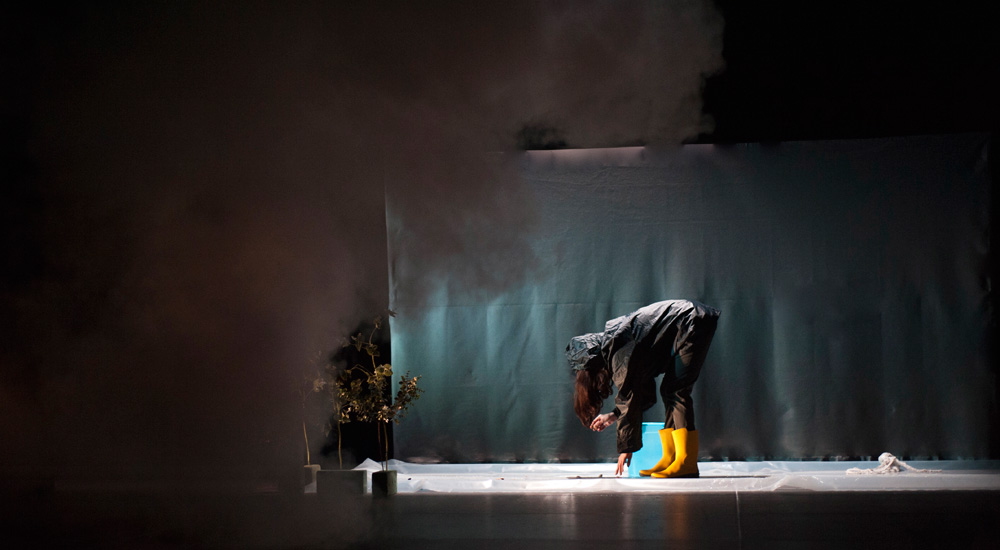my personal tarànto è uno spettacolo su Taranto. In scena una donna/ragazza e un uomo/ragazzo, non hanno nomi, l’ambientazione è distopica, i colori intermedi, tanto fumo, sedie di plastica e cose che volano. tarànto è un punto di vista di una persona anagraficamente appartenente alla città ma che se ne distanzia, la guarda da fuori, la vive come un turista o uno straniero con carta di identità a breve scadenza. Con quell’accento è un posto esotico, un tristissimo tropico da studiare e vivere tra se e sé. Questo punto di vista è ‘personal’, dichiaratamente legato a un vissuto personale ed è interessante nel momento in cui incarna spostamenti tra interno, esterno, distanza, avvicinamento a sé, immaginazione, visione e distorsione. my personal tarànto ha un’aria mentale antecedente ai Fatti, quando non c’era nessuno e c’era molto spazio per l’immaginazione.La città è presa in considerazione come una qualsiasi città in cui la vita va avanti saltando tra veleni. E un desiderio costante di evasione ne rende più vivida la permanenza. Lo spettacolo ha un’aria visiva di Realtà vista dai vetri della macchina mentre sta arrivando il parcheggiatore a chiedere soldi.
my personal tarànto vuol parlare di assetti umani particolarissimi. A Taranto si assiste ad un’estremizzazione molto agghiacciante e interessante: l’azione politico/economica non ha solo degli effetti nella vita quotidiana delle persone, a Taranto la politica entra proprio dentro le cellule delle persone, fino a modificarle.
C’è inoltre l’idea di completare questo progetto con due pièce che indaghino i passaggi successivi alla ‘vita che salta tra i veleni’: Ospedale Nord e La Votiva. my personal tarànto parla di vita in mezzo ai veleni, Ospedale Nord parla di morte e la Votiva di vita dopo la morte (la Votiva srl è l’ufficio dove la gente paga le bollette dell’illuminazione delle tombe dei propri cari)
my personal tarànto is a show concerning Taranto, the city where Europe’s biggest steel plant is located. Taranto is considered as the most polluted city of Europe.
Many problems affecting the city include economic and health issues such as cancer developing in infants and young children, breast milk contamination with dioxin and an increasing number of people falling ill.
The city is never mentioned throughout the whole theatrical performance, neither is the big industry. However at a certain point, Taranto becomes “tarànto”, a new abstract word meaning a “way of life” in toxic places”, that is in places where daily life is constantly threatened by poisons and death.
On the stage, a woman/girl and a man/boy are nameless, and the setting is dystopic. The colours are intermediate and there is smoke everywhere. The city is perceived from the point of view of a person who was born there but who is now a tourist or a stranger with a short -term passport. Thus Taranto becomes a distant exotic place, a gloomy tropical island to be observed and lived intimately. This new perspective is characterised by a constant shifting between inner and outer domains, voluntary and involuntary changing, self-forced leaving, vision and distortion.
Taranto is a place neglected by the media and by national politics, it is out of fashion. There is nobody but there is a lot of room for imagination. It is an ordinary place where life goes on, oscillating between the fear of poisons and the constant desire to escape from the city, which makes more meaningful the fact of staying there. There is no justice but a personal construction of meaning, a short- term meaning.
” It would be necessary to be everywhere, run away to many places and put yourself in one of those…how do you call them?
And launch yourself and meet everybody, but there isn’t any device like that ”
selezione Premio Scenario 2013
ideazione, regia, testi, oggetti, costumi Isabella Mongelli
sound design Alessandro Altavilla
attrezzeria M A R I O R O S S I lab
foto di Martina Leo/XfOTO

